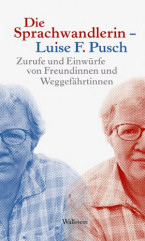
born on March 27, 1875 in Annecy in the Savoy, France
died on May 4, 1962 in Cambridge, England
Franco-German brain researcher and neurologist
150th birthday on March 27, 2025
Biography
Cécile Mugnier brought 30 brains into her marriage to the German neurologist Oskar Vogt in the spring of 1899, and these formed the basis for their lifelong scientific work together. As the bride, she had personally prepared each of the 30 items she selected for inclusion in her trousseau.
Cécile started studying medicine in Paris when she was 18. Her research career began at the Bicêtre Hospital under Pierre Marie, one of the leading neurologists of the time. She met her future husband, Oskar Vogt, while she was working at the hospital. One of only a few women to obtain a medical doctorate, she graduated in the winter of 1898/99. Shortly thereafter she chose to follow Oskar to Berlin, where the couple then began their collaboration. Over the following decades, they researched and worked together in several institutes.
As she was married to a scientist and worked in institutes in the private sector that were independent of universities, Cécile was free to pursue her own research objectives and to publish. In turn, Oskar benefited from her highly qualified, unpaid labor and her close contacts with important Parisian neurologists. International scientific marriages such as theirs were not uncommon at the turn of the century. The institutes were financed to a large extent through the couple’s neurological practice and through the generous support of the industrial magnate Friedrich A. Krupp, who suffered from mental illness and was a patient of Oskar’s.
In her research, Cécile was zealously focused on the field of genetically oriented neuroscience. She systematically developed a method for the serial production of brain specimens, whether of the brain in its entirety or cut into slices and then embedded in paraffin. The dissection required excellent manual dexterity and absolute precision; she built up a team of women technicians with the necessary skills by training them herself. The series of slices of human and animal brains that were produced continuously from 1901 at the Neurobiological Institute in Berlin and from 1959/60 at the Institute of Brain Research and General Biology in Neustadt still form the largest collection of its kind in the world today.
Cécile gave birth to two daughters. Supported by nannies and domestic staff, she could work without interruptions and her passion for scientific research remained undiminished.
The highest scientific honors, but also public and political conflicts, characterized the lives of Cécile and Oskar. Having “laid the essential foundations for our present understanding of the neuroanatomical structure of the human and mammalian cerebrum” (Satzinger), they are considered to be among the most important scientists of the first half of the 20th century.
Cécile worked until she was 84. After Oscar’s death, she moved to England to live with her daughter Marthe in Cambridge, where she died on May 4, 1962.
(Text from 1999; translated with DeepL.com; edited by Ramona Fararo, 2025. Please consult the German version for additional information, pictures, sources, videos, and bibliography.)
Author: Sibylle Dörr
Quotes
“Well, where is the immortal soul?” (Cécile Vogt on a tour of ‘her’ collection of dissected brains) Cécile knew every section and was informed about every case. Among them were the brains of many friends, such as that of Oskar's mentor Ferdinand Tönnies.)
If you hold the rights to one or more of the images on this page and object to its/their appearance here, please contact Fembio.



